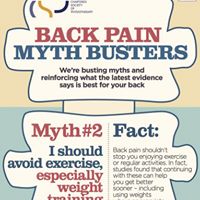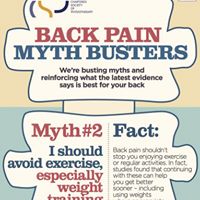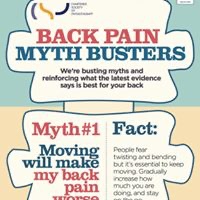Back Pain Myth 2 – I should avoid exercise, especially weight training
Back Pain Myth 2 – I should avoid exercise, especially weight training
With back pain affecting so many people, The Chartered Society of Physiotherapists (CSP) have produced a series of evidence based, myth busters to tackle the common myths surrounding back pain.
The CSP are busting myths about back pain and reinforcing what the latest evidence says is best for your back.
Myth 2 – I should avoid exercise, especially weight training
Exercise is generally accepted amongst all respected authorities to be the best modality for treating low back pain, in both the acute and chronic phases.
Studies have shown great benefits and long-term safety of various types of exercises, including high load resistance training.
Interestingly, according to research, no one type of exercise proves to be better or worse, so simply do what you enjoy and can tolerate! Gradually build up as your confidence and ability improves.
If you’re not feeling confident about exercising with or when you’re recovering from or had back pain, we provide additional support where you work on a specific exercise programme designed for your individual needs and goals.
#StrongerForLonger

References
O’Sullivan and Lin (2014) Acute low back pain Beyond drug therapies; Pain Management Today, Volume 1, Number 1.
Steele et al (2015) A Review of the Clinical Value of Isolated Lumbar Extension Resistance Training for Chronic Low Back Pain; American Academy of Physical Medicine and Rehabilitation Volume 7, Issue 2, Pages 169–187.
Searle et al (2015) Exercise interventions for the treatment of chronic low back pain: a systematic review and meta-analysis of randomised controlled trials; Clinical Rehabilitation 2015, Vol. 29(12) 1155 –1167.
Bjorn et al (2015) Individualized Low-Load Motor Control Exercises and Education Versus a High-Load Lifting Exercise and Education to Improve Activity, Pain Intensity, and Physical Performance in Patients With Low Back Pain: A Randomized Controlled Trial; Journal of Orthopaedic & Sports Physical Therapy, Volume:45 Issue:2 Pages:77-85.
Pieber et al (2014) Long-term effects of an outpatient rehabilitation program in patients with chronic recurrent low back pain; Eur Spine J 23:779–785.
Vincent et al (2014) Resistance Exercise, Disability, and Pain Catastrophizing in Obese Adults with Back Pain; Med Sci Sports Exerc. 46(9): 1693–170.
Smith et al (2014) An update of stabilisation exercises for low back pain: a systematic review with meta-analysis. BMC Musculoskeletal Disorders 15:416 DOI: 10.1186/1471-2474-15-416


